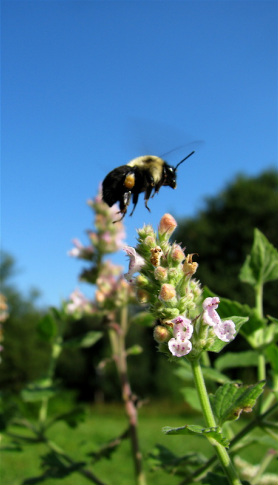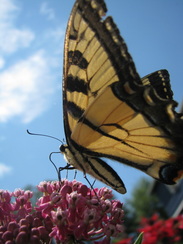Ecology and Environment
The Learning Sustainability Campaign is pleased to publish a new paper written in collaboration with members of the Western New York Environmental Alliance. "Biodiversity and Climate Change, A Biocentric Point of View".
Read the complete report here.
Read the complete report here.
Economics? Society? Environment?
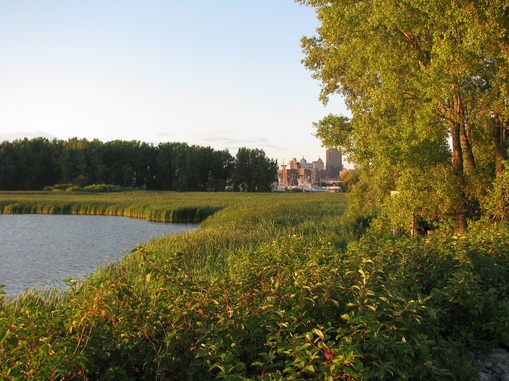
Times Beach Nature Preserve, part of the urban wilderness on Lake Erie in downtown Buffalo New York
The traditional tripod model of sustainable thinking and planning link the broad issues of economics, society and culture, and environment. What many sustainability thinkers advocate is that the real bottom line on sustainability is the environment. This is more of a science fact rather than a political opinion. It is the environment that created us and that keeps us strong, healthy, and alive. Indeed the constructs of economics are political in nature, and culture and society have evolved with both biological underpinnings, and deliberate political/religious/educational determination. Where our civilization fails, it fails because it lacks the critical recognition that environment and fundamental ecological integrity is not recognized as either a co-equal part of the tripod or as the real bottom line.
Climate and Action
If you doubt humanities contribution to climate change, variability, and global warming then learning sustainability may not be your forte. Without doubt the environment changes because that is what nature does on a moment to moment basis, including evolutionary biology and geological changes. Over the last 500 million years including the most recent ice-ages of about 12,000 years ago, there have been gigantic climate shifts. Science tells us that there are reasons for these episodes. Current science says pretty clearly that human activity is or has pushed our climate stability beyond the tipping point.
We should not only be accepting the realities of warming temperatures and rising sea levels, but we should be well-advanced in our thinking and strategies on how to deal with the ongoing and onrushing changes. Everywhere on the planet is and will be effected including the very spot where you are sitting as you read this. There is a great deal of detailed information available including region by region evaluations, predictions, and planning concepts.
There are two significant issues that humans must deal with in order to address strategies involving the changes. Economic development is at the heart of both of these issues. Growth without limits suggests for instance that energy growth is a constant. How we manage our energy, fossil v. renewables is a primary subject of sustainability thinkers. We have cultural and political choices. Fining ways to make these choices is a complex obstacle driven by a non recognition of the integration of sustainable concepts- economy, society, and ecology. It seems that our world's political cultures which is driven by growth strategies has decided that energy growth is a must. The question has to be is can this planet sustain growth, given the problems and limits that we are facing regarding industrial wind energy development and solar design issues. These problems include cost, effectiveness, and unfortunately the emerging toxic impacts of some of these technologies on humans. Why is not energy conservation a major strategy?
The other significant factor contributing to climate change is habitat loss and the reduction of the earth's biodiversity. Oceans and forests for instance are primary sources for carbon sequestration. As we destroy these entities, we have ended all hope of of preventing climate change and the consequences that are sure to come. Now we must plan for a future characterized by science and policy focused on climate change and action strategies.
Get involved, learn, act. We will post more on climate and action soon.
We should not only be accepting the realities of warming temperatures and rising sea levels, but we should be well-advanced in our thinking and strategies on how to deal with the ongoing and onrushing changes. Everywhere on the planet is and will be effected including the very spot where you are sitting as you read this. There is a great deal of detailed information available including region by region evaluations, predictions, and planning concepts.
There are two significant issues that humans must deal with in order to address strategies involving the changes. Economic development is at the heart of both of these issues. Growth without limits suggests for instance that energy growth is a constant. How we manage our energy, fossil v. renewables is a primary subject of sustainability thinkers. We have cultural and political choices. Fining ways to make these choices is a complex obstacle driven by a non recognition of the integration of sustainable concepts- economy, society, and ecology. It seems that our world's political cultures which is driven by growth strategies has decided that energy growth is a must. The question has to be is can this planet sustain growth, given the problems and limits that we are facing regarding industrial wind energy development and solar design issues. These problems include cost, effectiveness, and unfortunately the emerging toxic impacts of some of these technologies on humans. Why is not energy conservation a major strategy?
The other significant factor contributing to climate change is habitat loss and the reduction of the earth's biodiversity. Oceans and forests for instance are primary sources for carbon sequestration. As we destroy these entities, we have ended all hope of of preventing climate change and the consequences that are sure to come. Now we must plan for a future characterized by science and policy focused on climate change and action strategies.
Get involved, learn, act. We will post more on climate and action soon.
Biodiversity and the Biosphere
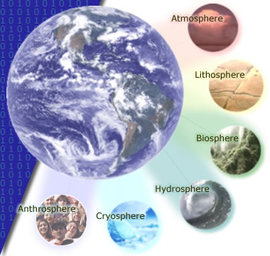
Source: Institute for Computational Earth System Science
Biological diversity is the comprehensive and interlinked system of life, habitat, and ecosystems that are identified as life on the earth. Some think that the entire planet, from biosphere to surface to inner structure is a living organism that has the same interconnected capacity to change and react as any living organism does.
The Convention on Biological Diversity defines biodiversity as: "the variability among living organisms from all sources including, inter alia, terrestrial, marine and other aquatic ecosystems and the ecological complexes of which they are a part; this includes diversity within species, between species, and of ecosystems."
Biodiversity and its interconnected parts are what makes life on earth sustainable. Understanding it is a core ecological concept.
According to the Encyclopedia of Earth:
"The biosphere is the biological component of earth systems, which also include the lithosphere, hydrosphere, atmosphere, and other "spheres" (e.g. cryosphere,,anthrosphere, etc.). The biosphere includes all living organisms on earth, together with the dead organic matter produced by them.
The biosphere concept is common to many scientific disciplines including astronomy, geophysics, geology, hydrology, biogeography and evolution, and is a core concept in ecology, earth science and physical geography. A key component of earth systems, the biosphere interacts with and exchanges matter and energy with the other spheres, helping to drive the global biogeochemical cycling of carbon, nitrogen, phosphorus, sulfur and other elements. From an ecological point of view, the biosphere is the "global ecosystem", comprising the totality of biodiversity on earth and performing all manner of biological functions, including photosynthesis, respiration, decomposition, nitrogen fixation and denitrification.
The biosphere is dynamic, undergoing strong seasonal cycles in primary productivity and the many biological processes driven by the energy captured by photosynthesis. Seasonal cycles in solar irradiation of the hemispheres is the main driver of this dynamic, especially by its strong effect on terrestrial primary productivity in the temperate and boreal biomes, which essentially cease productivity in the winter time.
The biosphere has evolved since the first single-celled organisms originated 3.5 billion years ago under atmospheric conditions resembling those of our neighboring planets Mars and Venus, which have atmospheres composed primarily of carbon dioxide. Billions of years of primary production by plants released oxygen from this carbon dioxide and deposited the carbon in sediments, eventually producing the oxygen-rich atmosphere we know today. Free oxygen, both for breathing (O2, respiration) and in the stratospheric ozone (O3) that protects us from harmful UV radiation, has made possible life as we know it while transforming the chemistry of earth systems forever.
As a result of long-term interactions between the biosphere and the other earth systems, there is almost no part of the earth's surface that has not been profoundly altered by living organisms. The earth is a living planet, even in terms of its physics and chemistry. A concept related to, but different from, that of the biosphere, is the Gaia hypotheses, which posits that living organisms have and continue to transform earth systems for their own benefit.
The Convention on Biological Diversity defines biodiversity as: "the variability among living organisms from all sources including, inter alia, terrestrial, marine and other aquatic ecosystems and the ecological complexes of which they are a part; this includes diversity within species, between species, and of ecosystems."
Biodiversity and its interconnected parts are what makes life on earth sustainable. Understanding it is a core ecological concept.
According to the Encyclopedia of Earth:
"The biosphere is the biological component of earth systems, which also include the lithosphere, hydrosphere, atmosphere, and other "spheres" (e.g. cryosphere,,anthrosphere, etc.). The biosphere includes all living organisms on earth, together with the dead organic matter produced by them.
The biosphere concept is common to many scientific disciplines including astronomy, geophysics, geology, hydrology, biogeography and evolution, and is a core concept in ecology, earth science and physical geography. A key component of earth systems, the biosphere interacts with and exchanges matter and energy with the other spheres, helping to drive the global biogeochemical cycling of carbon, nitrogen, phosphorus, sulfur and other elements. From an ecological point of view, the biosphere is the "global ecosystem", comprising the totality of biodiversity on earth and performing all manner of biological functions, including photosynthesis, respiration, decomposition, nitrogen fixation and denitrification.
The biosphere is dynamic, undergoing strong seasonal cycles in primary productivity and the many biological processes driven by the energy captured by photosynthesis. Seasonal cycles in solar irradiation of the hemispheres is the main driver of this dynamic, especially by its strong effect on terrestrial primary productivity in the temperate and boreal biomes, which essentially cease productivity in the winter time.
The biosphere has evolved since the first single-celled organisms originated 3.5 billion years ago under atmospheric conditions resembling those of our neighboring planets Mars and Venus, which have atmospheres composed primarily of carbon dioxide. Billions of years of primary production by plants released oxygen from this carbon dioxide and deposited the carbon in sediments, eventually producing the oxygen-rich atmosphere we know today. Free oxygen, both for breathing (O2, respiration) and in the stratospheric ozone (O3) that protects us from harmful UV radiation, has made possible life as we know it while transforming the chemistry of earth systems forever.
As a result of long-term interactions between the biosphere and the other earth systems, there is almost no part of the earth's surface that has not been profoundly altered by living organisms. The earth is a living planet, even in terms of its physics and chemistry. A concept related to, but different from, that of the biosphere, is the Gaia hypotheses, which posits that living organisms have and continue to transform earth systems for their own benefit.
Climate Change and Global Warming
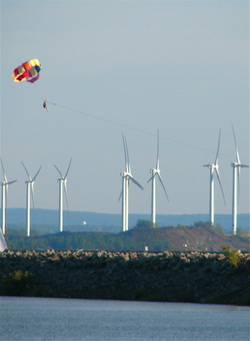
Another view from Times Beach Nature Preserve
One of if not the most fundamental challenges to our and coming generations is human impact on environment and in particular how that impact contributes to global warming. The science is nearly overwhelming that human activity including the release of greenhouse gasses is responsible for shifts in climate and climate variability. This will fundamentally transform life on earth as we know it. The ongoing and anticipated effects are well known and include increased ocean levels thus radically changing traditional developed shorelines and communities, and less predictable storms with increased intensity. One of the culprits is economic politics. Growth without even a mild discussion on limits leads to abuse of natural resources and habitats, and a somewhat misleading approach to energy strategies. While renewable energy strategies such as wind and solar hold some promise there are numerous problems associated with energy growth that are simply unsustainable no matter what the source of energy. Both industrial wind and solar strategies, for instance, have substantial environmental impacts on biodiversity and leave somewhat of a toxic imprint on third world communities involved with, for instance, extraction and processing of rare earth elements. The issues are of course complex, and the answers are not easy to come by. But if science points to the environment being the bottom line, perhaps we should be thinking about the political decisions that have lead us to economic systems that promote growth and profit over all other goals including sustainability, a sustainable environment, and a sustainable global society. Unlimited growth including unlimited growth in the energy sector in our rapidly expanding world may be the deal breaker that proves that a sustainable planet is impossible.
